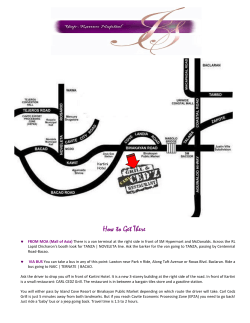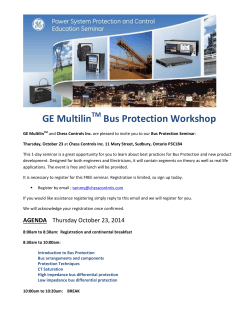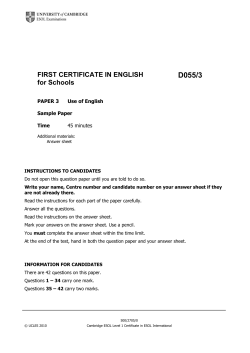
Presentation - Future Powertrain Conference
GKN Hybrid Power :The use of the Gyrodrive hybrid system in bus, truck and off highway vehicles GKN Hybrid Power – Success and Growth Growth of the GKN Hybrid Team This team has developed a leading technology, now moving into production Heads Achievements 2007 4 F1 system developed 2008 5 F1 system run 2009 10 Porsche GT3R Hybrid developed 2010 15 Porsche Hybrid raced & won 2011 25 Audi e-tron Quattro developed; investment in industrialization 2012 35 Bus & Tram demonstrator contracts; Audi R18 etron quattro raced & won 2013 46 Bus demonstrator efficacy proved; Significant increase in interest within bus industry; Audi R18 e-tron quattro 2.0 raced and won 2014 98 Pre-Production Orders for 500+ Bus systems. Alexander Dennis Partnership. Audi R18 e-tron quattro 2.0 raced and won; DSTL contract and …..we’re now GKN WHP’s 2 Flywheel Hybrid System - Principle of Operation FESS = Flywheel Energy Storage System 1-Power Inverter 2-Motor Gearbox 3-HV Bus 4/5-FESS 3 The Mk4 Flywheel – Section View Mk 4 Flywheel Assembly Section Phase Connection Sensor Harness Connector Stator Cooling Connection Top Containment Bearing Cooling Connection Upper Bearing Stator Stator Cooling System Carbon Rotor Lower Bearing MLC Bearing Housing Glass Ring Fixings between Containments Rotor End Cap Lower Containment Rotor Shaft Anti Vibration Mount Flywheel Assy Mounting Screws Rotor Nut Mounting Plate (Vehicle) Pressure Burst Discs 4 The Flywheel Rotor • Filament wound carbon T800 • MLC for rotor magnetics • Super precision fits and tolerances • Carbon Fibre end cap F1 technology 5 Energy and Power – Why Flywheels? Maxwell Boostcap (Super Cap) GKN HP MK4 Flywheel Cont. input 120 kW Cont. input 120 kW Cont. input 120 kW 240 kg 370 kg 55 kg ~1,000 cycle life ~1,000,000 cycle life >1,000,000 cycle life 390 kJ/kg 6.3 kJ/kg 30 kJ/kg 93.6 MJ 2.4MJ 1.6MJ Boost Power up to 120kW for Bus and ~300kW for Msport. Power Delivery / Harvesting for 2-10 seconds Electrical Power (kW) Power & Energy : 400V Power / Energy Mechanical Energy (kJ) 140 0.35kW/kg 2.2kW/kg (6 kW/kg Msport) Think about the Mass The Flywheel uses ~80% of its stored energy per cycle. Life costs…. Flywheel 15 years……Battery 4 years 2000 1800 120 1600 Electrical Power (kW) 0.5 kW/kg 100 1400 1200 80 1000 60 800 600 40 400 20 200 0 Disposal cost and environmental impact !! 0 0 5000 10000 15000 20000 RPM 6 25000 30000 35000 40000 Mechanical Energy kJ A123 Li-ion (Battery) Flywheel Key Facts Centrifugal force – 80,000,000 Fibres 250,000 x gravity Population of Germany Mass of 6.5g > 1.6T Rotor surface speed 600 m/s (Mach 1.8) Centre of balance accuracy 2 um Rotor Energy 1.2 MJ 1/100 diameter of human hair 4 Hobnobs 7 Bus & Truck Applications 8 [DOCUMENT NAME] 8 Hybrid Bus Programme GKN HP Flywheel GKN Motor & Gearbox BRAKING Power Electronics ACCELERATING Re- Gen Braking Saving Up to 25% depending on route Through the motor / generator in the driveline the Gyrodrive flywheel captures the kinetic energy during braking and reuses it to help accelerate the bus. 9 The Gyrodrive Cubicles Cooling and Oil Circulation Mk 4 Flywheel HV Power Power Inverters FW / MGU Vacuum System System Controller 10 Bus Installation FESS and MGU Motor and Gearbox Unit WRIGHTBUS Installation Design……...……….. Develop…………………. Realise FESS Concept Design Alexander Dennis E400 Installation 11 GKN Hybrid Power – Building Commercial Success Reliable Operation Real World Results Commercially Viable • Initial Focus UK Bus market 30,000 buses in UK 8,000 in London – dominates UK market Split between Retro fit and New Build We drive the wheels of hundreds of millions of cars… • Retro –fit programme with Go-Ahead supported by TSB funding • OEM Project with ADL supported by APC funding We help thousands of aircraft to fly… 12 Parallel Hybrid System Parallel Hybrid Bus • • Cost Increase offset by fuel save Re- Gen Braking Saving Up to 25% depending on route 13 Kinetic energy re-used Diesel Engine sized for peak performance What is the Market? Fuel Save Payback map Bus Refuse Trucks Light CV 50,000 100,000 Heavy CV 150,000 14 200,000 Annual Mileage Series Hybrid Bus System Parallel Hybrid Bus • • Future Development Cost Increase offset by fuel save Kinetic energy re-used Diesel Engine sized for peak performance Series Hybrid Bus • Small engine and deleted driveline offset on cost Optimised Engine Fuel Use Saving 28 % • • • • Re- Gen Braking + Saving (average) 20 % 15 = Engine sized for average power use Peak power demands met from flywheel Kinetic energy re-used Greater fuel saving Savings in engine, transmission and driveline costs offset system costs Total Saving 42 % Series Hybrid Benefit Fuel Save Payback map Bus Refuse Trucks Light CV 50,000 100,000 Heavy CV 150,000 16 200,000 Annual Mileage Hybrid Bus Systems Parallel Hybrid Bus • • Kinetic energy re-used Diesel Engine sized for peak performance Future Developments Series Hybrid Bus • • • • • Engine sized for average power use Peak power demands met from flywheel Kinetic energy re-used Greater fuel saving Savings in engine, transmission and driveline costs offset system costs Battery EV Bus • • • • 17 Flywheel used to manage energy flow Kinetic energy re-used Higher range Longer battery life Delivery Truck Engines Parallel Hybrid Series Hybrid Smallest Largest Power kW 115 220 Torque Nm 650 1,200 Cylinders 4 6 Size l 5.1 7.7 Smallest EVO 140 Combined Power kW 115 94 209* Torque Nm 650 600 1,250 * Limited by flywheel capacity so will restrict gradient climbing ability Alternative engine Smaller higher speed diesels (derived from passenger cars) will allow further downsizing 3.5l 190kW 650Nm could improve efficiency further 18 Wheel Loader Shovel 19 [DOCUMENT NAME] 19 Benefits of eDrive Hybrid Technology Current Drivetrain eDrive Series Hybrid Drivetrain Engine sized to produce maximum workload Engine sized to produce the average power requirement Ancillary losses Power on demand to ancillaries Mechani cal losses Energy to move, lift, shift Average Power Requirement Braking Energy Re-captured Energy lost in braking Engine Downsize Saving 24 % + Re- Gen Energy Saving 25 % 20 = Total Saving 43 % Wheel Loader Shovel Concept Wheel Loader eDrive Hybrid Wheel Loader 8L Engine Generator Power 170 kW − 3l Engine Torque 1,160 Nm − 72 kw − GKN EVO AF140 Generator GKN EVO AF 240 Drive motors − Power 188 kW (Peak 400 kW) − Torque 520 Nm (Peak 1,200Nm) Electric driven hydraulics & cooling Power balance through on-board GKN Hybrid Flywheel energy store Hidden Benefits Design freedom for engine package Eliminate operator error Ease of Control Noise Reduction 21 Industrial Energy Storage 22 [DOCUMENT NAME] 22 Industrial FESS System (20MJ) Control Control System Application Controller (SAC) Control Safety Circuit Flywheel Energy Storage System (FESS) HV DC Bus Control Control FESS Supervisor Controller (FSC) Power Supply Mk8 Flywheel Module (x6) Load Control Control Flywheel Controller FW Inverter Flywheel Ancillaries Mk8 Flywheel Source: 23 Power Distribution
© Copyright 2025










